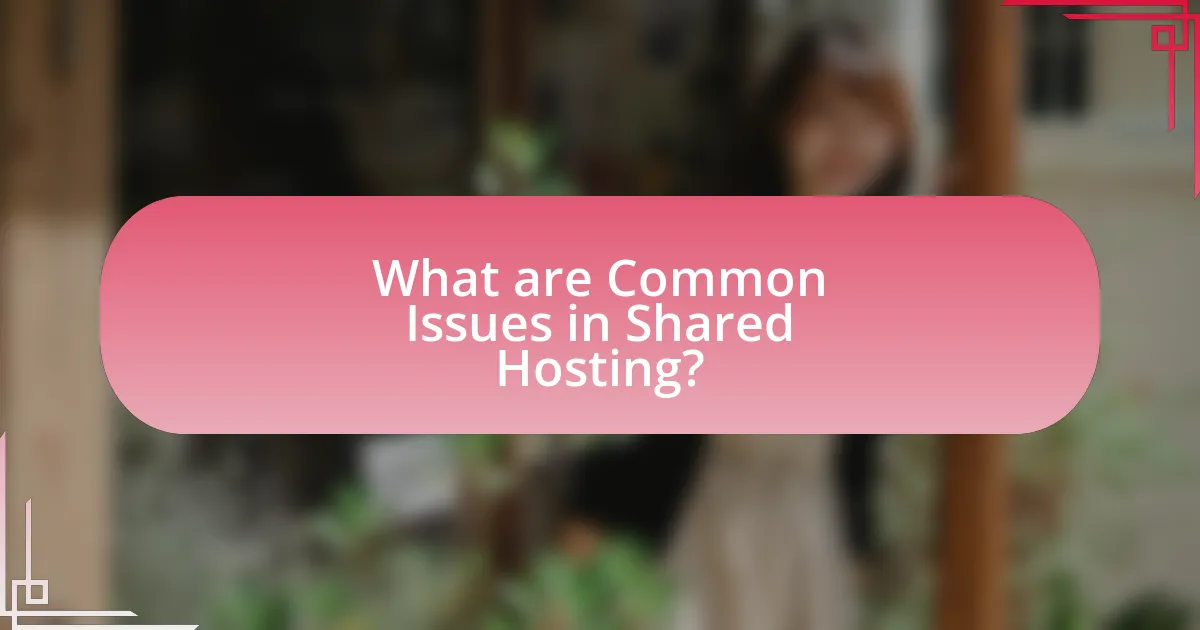The article focuses on troubleshooting common issues in shared hosting environments, highlighting key challenges such as limited resources, security vulnerabilities, performance degradation, and lack of control over server configurations. It outlines how these issues impact website performance, including slow loading times and frequent downtime, and identifies signs of performance problems. The article also discusses effective troubleshooting steps, tools for diagnosing hosting issues, and best practices for maintaining reliability and security in shared hosting. By addressing user behavior and server configuration, it provides a comprehensive guide to optimizing website functionality and preventing future problems.

What are Common Issues in Shared Hosting?
Common issues in shared hosting include limited resources, security vulnerabilities, performance degradation, and lack of control over server configurations. Limited resources arise because multiple users share the same server, which can lead to slow loading times and downtime during peak usage. Security vulnerabilities are prevalent as a single compromised account can jeopardize the entire server. Performance degradation occurs when one website consumes excessive bandwidth or CPU, affecting others on the same server. Lastly, users have limited control over server settings, which can hinder the ability to optimize their websites effectively. These issues are well-documented in industry reports, highlighting the challenges faced by users in shared hosting environments.
How do these issues impact website performance?
Issues in shared hosting, such as limited resources, server overload, and poor configuration, significantly impact website performance by causing slow loading times and increased downtime. Limited resources, typical in shared hosting environments, restrict the amount of CPU and memory available to each website, leading to slower response times during peak traffic. Server overload occurs when multiple websites share the same server resources, resulting in degraded performance for all sites hosted on that server. Additionally, poor configuration can lead to inefficient resource allocation and increased latency. According to a study by Google, a one-second delay in page load time can lead to a 20% decrease in conversions, highlighting the critical nature of these issues on overall website performance.
What are the signs of performance issues in shared hosting?
Signs of performance issues in shared hosting include slow website loading times, frequent downtime, and unresponsive applications. These indicators suggest that the server resources are being overutilized due to multiple users sharing the same environment. For instance, if a website takes longer than three seconds to load, it may signal that the server is struggling to handle the traffic or resource demands. Additionally, if users experience regular timeouts or errors when accessing the site, it further confirms that performance issues are present. Monitoring tools can also reveal high CPU and memory usage, which are critical signs of resource contention in shared hosting environments.
How can resource limitations affect website functionality?
Resource limitations can significantly impair website functionality by restricting the available bandwidth, processing power, and storage capacity. When a website operates on shared hosting, multiple sites compete for the same resources, leading to slower load times, increased downtime, and potential crashes during high traffic periods. For instance, a study by Google found that a one-second delay in page load time can result in a 20% decrease in conversions, highlighting the direct impact of resource constraints on user experience and business performance.
Why do these issues occur in shared hosting environments?
Issues occur in shared hosting environments primarily due to resource limitations and the sharing of server resources among multiple users. In shared hosting, multiple websites operate on the same server, which can lead to performance degradation when one site consumes excessive bandwidth or CPU resources. This resource contention can result in slow loading times, downtime, and security vulnerabilities, as the actions of one user can impact others on the same server. Additionally, shared hosting often lacks the customization and control available in dedicated hosting, making it difficult to optimize performance for specific applications.
What role does server configuration play in common issues?
Server configuration plays a critical role in common issues by directly influencing performance, security, and compatibility. Misconfigured settings can lead to slow response times, increased downtime, and vulnerabilities to attacks. For instance, improper allocation of resources such as CPU and memory can cause websites to crash under traffic loads, while incorrect permissions can expose sensitive data. Additionally, outdated software configurations may result in compatibility issues with applications, leading to errors and malfunctions. These factors highlight the importance of meticulous server configuration in maintaining optimal functionality and security in shared hosting environments.
How does user behavior contribute to hosting problems?
User behavior significantly contributes to hosting problems through actions such as excessive resource consumption, improper configuration, and security vulnerabilities. For instance, when users run resource-intensive applications or scripts, they can exceed the allocated CPU and memory limits, leading to slow performance or downtime for all users on a shared server. Additionally, misconfigurations, such as incorrect file permissions or settings, can create security loopholes, making the server susceptible to attacks. According to a study by the Hosting Industry Association, 30% of hosting issues stem from user errors, highlighting the impact of user behavior on overall server stability and performance.

How to Identify Common Issues in Shared Hosting?
To identify common issues in shared hosting, monitor website performance, check server response times, and review error logs. These actions help pinpoint problems such as slow loading speeds, frequent downtime, or error messages. For instance, tools like Google PageSpeed Insights can reveal performance bottlenecks, while server logs can indicate issues like 500 Internal Server Errors or 404 Not Found errors. Regularly assessing these factors allows users to address issues promptly and maintain optimal website functionality.
What tools can help diagnose hosting problems?
Tools that can help diagnose hosting problems include Pingdom, GTmetrix, and New Relic. Pingdom provides uptime monitoring and performance insights, allowing users to identify slow response times and downtime issues. GTmetrix analyzes website speed and performance, offering detailed reports on load times and recommendations for improvement. New Relic offers application performance monitoring, enabling users to track server health and pinpoint bottlenecks in real-time. These tools are widely recognized in the industry for their effectiveness in diagnosing hosting-related issues.
How do monitoring tools assist in identifying issues?
Monitoring tools assist in identifying issues by continuously tracking system performance metrics and alerting users to anomalies. These tools analyze data such as CPU usage, memory consumption, and network traffic, enabling quick detection of irregularities that may indicate underlying problems. For instance, a study by Gartner highlights that organizations using monitoring tools can reduce downtime by up to 50%, demonstrating their effectiveness in preemptively identifying issues before they escalate.
What logs should be checked for troubleshooting?
For troubleshooting in shared hosting, the primary logs to check are the error logs, access logs, and application logs. Error logs provide insights into server-side issues, detailing problems encountered by the server while processing requests. Access logs record all requests made to the server, which can help identify unusual patterns or unauthorized access attempts. Application logs, specific to the software running on the server, can reveal issues related to the application itself, such as database connection errors or script failures. These logs are essential for diagnosing and resolving common issues effectively.
What are the common symptoms of shared hosting issues?
Common symptoms of shared hosting issues include slow website performance, frequent downtime, and error messages such as “503 Service Unavailable.” Slow performance often arises from resource limitations, as multiple websites share the same server resources, leading to congestion. Frequent downtime can occur due to server overload or maintenance, impacting all sites hosted on that server. Error messages indicate server-related problems, often linked to high traffic or misconfigurations. These symptoms are indicative of the shared hosting environment’s limitations, where resource contention among users can significantly affect website functionality.
How can slow loading times indicate a problem?
Slow loading times can indicate a problem with server performance or resource allocation in shared hosting environments. When a website experiences delays in loading, it often points to insufficient bandwidth, high server load, or misconfigured settings that hinder optimal performance. For instance, studies show that a one-second delay in page response can lead to a 7% reduction in conversions, highlighting the impact of loading times on user experience and business outcomes. Additionally, tools like Google PageSpeed Insights can help diagnose specific issues contributing to slow loading, reinforcing the need for timely troubleshooting to maintain website efficiency.
What does frequent downtime suggest about hosting quality?
Frequent downtime suggests poor hosting quality. This indicates that the hosting provider may lack reliable infrastructure, adequate resources, or effective management practices. For instance, a study by HostingFacts revealed that 99.9% uptime is the industry standard, and providers failing to meet this benchmark often struggle with server reliability and maintenance. Therefore, consistent downtime is a clear indicator of subpar hosting services.

What are Effective Troubleshooting Steps for Shared Hosting Issues?
Effective troubleshooting steps for shared hosting issues include checking server status, reviewing error logs, verifying DNS settings, and testing website performance. First, users should confirm if the server is operational by accessing the hosting provider’s status page or contacting support. Next, examining error logs can reveal specific issues affecting website functionality, such as script errors or resource limits. Additionally, verifying DNS settings ensures that domain names correctly point to the server’s IP address, which is crucial for website accessibility. Finally, testing website performance using tools like GTmetrix or Pingdom can help identify slow loading times or downtime, allowing users to address these issues promptly. These steps are essential for maintaining optimal performance and resolving common problems in shared hosting environments.
How can you resolve slow website performance?
To resolve slow website performance, optimize your website by reducing file sizes, leveraging browser caching, and minimizing HTTP requests. Reducing file sizes can be achieved through image compression and minifying CSS and JavaScript files, which decreases load times. Leveraging browser caching allows frequently accessed resources to be stored locally on users’ devices, reducing server load and improving speed. Minimizing HTTP requests involves combining files and using CSS sprites, which can significantly enhance loading efficiency. According to Google, optimizing these elements can lead to a performance improvement of up to 50%, demonstrating the effectiveness of these strategies in enhancing website speed.
What optimizations can improve loading speed?
Optimizations that can improve loading speed include minimizing HTTP requests, optimizing images, leveraging browser caching, and using a Content Delivery Network (CDN). Minimizing HTTP requests reduces the number of elements that need to be loaded, which can significantly decrease load times. Optimizing images by compressing them without losing quality can reduce file sizes, leading to faster loading. Leveraging browser caching allows frequently accessed resources to be stored locally on a user’s device, decreasing load times for repeat visits. Utilizing a CDN distributes content across multiple servers globally, ensuring that users access data from the nearest location, which enhances loading speed. These strategies are supported by studies indicating that reducing load times can improve user experience and increase conversion rates.
How does caching help in troubleshooting performance issues?
Caching helps in troubleshooting performance issues by storing frequently accessed data in a temporary storage area, which reduces the time needed to retrieve that data. This mechanism allows for quicker access to information, thereby improving response times and overall system performance. When performance issues arise, analyzing cache hit rates can reveal whether the system is effectively utilizing cached data or if there are underlying problems, such as inefficient queries or resource bottlenecks. For instance, a high cache hit rate indicates that the caching mechanism is functioning well, while a low rate may suggest that the application is not optimized for caching, leading to performance degradation.
What steps should be taken for resolving downtime?
To resolve downtime, first, identify the cause by checking server status and logs for errors. Next, restart the affected services or the server itself to restore functionality. If the issue persists, contact your hosting provider for support, as they can provide insights into server-side problems. According to a 2021 study by the Uptime Institute, 70% of downtime incidents are due to human error, emphasizing the importance of thorough investigation and prompt action.
How can you check server status and uptime?
To check server status and uptime, use monitoring tools or services that provide real-time data on server performance. Tools like UptimeRobot, Pingdom, or server command-line utilities such as “uptime” or “top” can display the current status and uptime metrics. These tools typically report the duration the server has been running since the last reboot, along with response times and downtime incidents, ensuring accurate tracking of server reliability.
What actions can be taken if the server is down?
If the server is down, the first action to take is to check the server status through a monitoring tool or service. This helps determine if the issue is widespread or isolated. Next, restart the server if you have administrative access, as this can resolve temporary glitches. If the problem persists, contact your hosting provider for assistance, as they can provide insights into server outages or maintenance activities. Additionally, reviewing server logs can help identify specific errors that may have caused the downtime. These steps are effective because they address both immediate and underlying issues, ensuring a systematic approach to troubleshooting server downtime.
What best practices can prevent future issues in shared hosting?
Implementing strong security measures is a best practice that can prevent future issues in shared hosting. Regularly updating software, including the content management system and plugins, reduces vulnerabilities that could be exploited by attackers. Additionally, using strong, unique passwords for all accounts minimizes the risk of unauthorized access. Monitoring resource usage helps identify potential overages that could lead to performance issues, while regular backups ensure data recovery in case of failure. According to a study by the Ponemon Institute, 60% of small businesses that experience a data breach go out of business within six months, highlighting the importance of these practices in maintaining a secure and reliable hosting environment.
How can regular maintenance improve hosting reliability?
Regular maintenance enhances hosting reliability by ensuring that servers operate optimally and remain secure. Routine tasks such as software updates, hardware checks, and performance monitoring help identify and resolve potential issues before they escalate into significant problems. For instance, a study by the Ponemon Institute found that organizations that conduct regular maintenance experience 50% fewer downtime incidents compared to those that do not. This proactive approach minimizes service interruptions and enhances overall user experience, thereby reinforcing the reliability of hosting services.
What role does choosing the right hosting plan play in avoiding issues?
Choosing the right hosting plan is crucial in avoiding issues such as downtime, slow loading speeds, and limited resources. A suitable hosting plan aligns with the specific needs of a website, ensuring adequate bandwidth, storage, and support. For instance, a plan with sufficient resources can handle traffic spikes without crashing, while a plan with robust customer support can quickly resolve technical problems. According to a study by HostingAdvice, 47% of users expect a website to load in two seconds or less, highlighting the importance of selecting a plan that optimizes performance.















